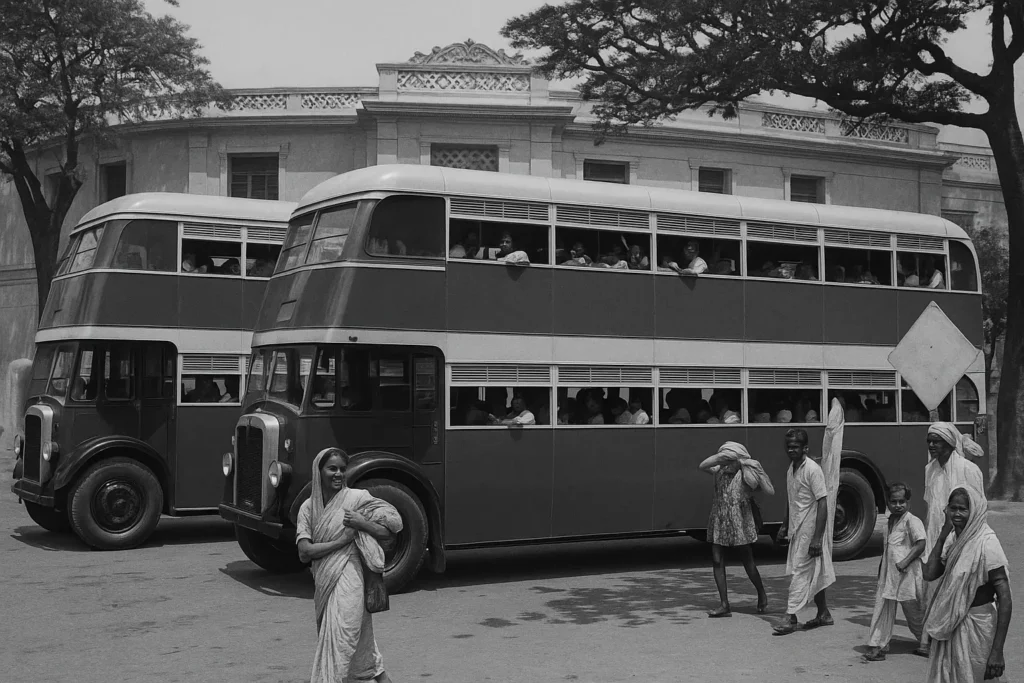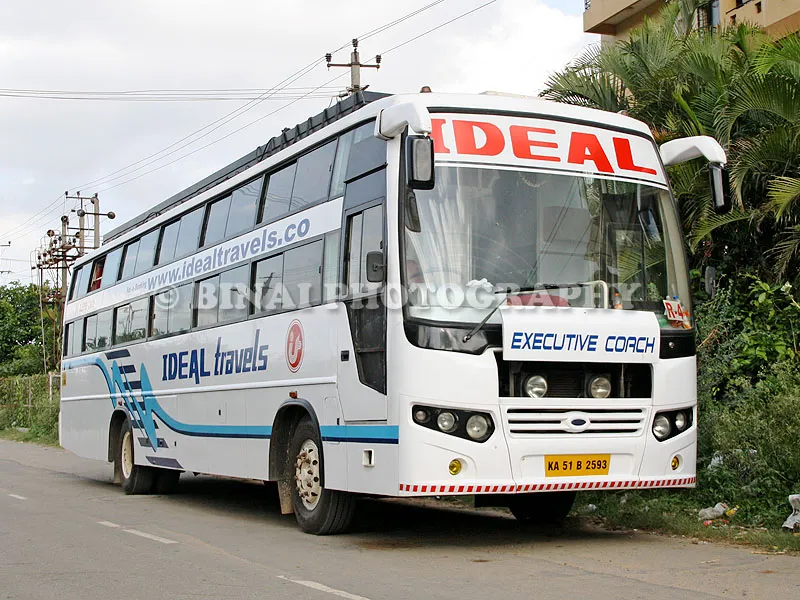Bus travel in India has transformed dramatically over the years. What once served primarily as a feeder mode of transport or even a basic long-distance travel option has evolved into a sophisticated industry. The rise of powerful luxury buses, coupled with the rapid development of highways, has fueled this remarkable growth. In Part 1 of this series, I explored the early changes in bus designs and operations. The last two decades, in particular, have been a thrilling period for bus travel in India.
Memories of Long-Distance Buses Before 2000
Before diving into recent changes, let me take you back to the late 1990s. During 1999-2000, my daily observations included long-distance buses running between Mumbai and Mangalore operators like CPC and Ballal. These buses took about 24 hours to cover the route, often carrying bulky cargo on their roofs. At that time, the Mumbai-Pune Expressway was not yet operational, so these buses took routes passing through the outskirts of Mumbai, where I lived. These were all seater buses, and I often wondered how passengers could endure such long journeys sitting upright.

The First Sleeper Bus Encounter – Early 2000s
In the early 2000s, during a school outing to Mumbai’s Fort area, I spotted a unique bus operated by Paulo Holiday Makers from Goa. This bus had its entrance in the middle and featured a hybrid seating arrangement: one half with seats and the other half with sleeping berths aligned along the direction of travel, similar to Indian Railways’ side berths. Though I couldn’t enter the bus, it left a strong impression as the first sleeper bus I had ever seen. The body was built by a Goan manufacturer called Damodar.

The Rise of Sleeper Buses (Mid-2000s to 2010)
Fast forward a few years to around 2005, sleeper buses became more common, moving beyond Paulo’s initial design to fully-fledged sleeper coaches. Around 2007-08, I spotted an AC sleeper bus from NWKRTC named “Corona.” This rear-engine bus resembled a Volvo and marked the arrival of a new commercial vehicle manufacturer in India that imported technology from MAN Neoplan coaches.
By 2008, after moving to Bengaluru, I saw sleeper buses dominating many routes, with some even outnumbering seater buses. Operators offered seater-cum-sleeper options, especially on routes to Kerala. KSRTC launched a Corona sleeper service to Ernakulam in 2010, which, despite initial setbacks, was eventually upgraded to a Volvo sleeper model and continues today.

Sleeper Buses Gain Market Share
Sleeper buses gained popularity quickly due to their cost-effectiveness: an operator could buy two sleeper coaches for the price of one multi-axle seater coach. Lower taxes and operating expenses added to their appeal, along with the ability to charge higher fares. Manufacturers like Mercedes-Benz (through Sutlej) and Isuzu also introduced sleeper models, while Volvo began offering unfinished shells designed for sleeper conversions around 2012-13.
KPN, a prominent operator, was among the first in South India to adopt these converted sleeper coaches. Following them, many others like Kallada, Sharma, and VRL jumped on the bandwagon, converting older seater buses to sleepers, often charging a premium.
Sleeper Coach Configurations Around 2015
Around 2015, two main types of sleeper layouts dominated the market:
- Longitudinal berth arrangement (2×1 configuration) — one berth on the left and two on the right side, common across most states.
- Railway-style cabin arrangement — four-berth cabins, mostly seen in Andhra Pradesh.
However, regulations varied widely by state. Tamil Nadu and Kerala, for example, did not allow sleeper bus registrations, while Karnataka only issued Contract Carriage permits. This led operators to register buses in more permissive states like Odisha or even northeastern states such as Nagaland and Arunachal Pradesh, where regulations were lax. These distant registrations sometimes compromised vehicle inspections and fitness certifications.
Standardization and Regulatory Changes
In 2015, the Automobile Research Association of India (ARAI) introduced a standardized bus body code (AIS:052) for seater coaches, followed by an amended code for sleeper coaches (AIS:119) in 2016. These regulations came into effect from 2018 onward, prompting more states to allow sleeper bus registrations. However, permit issues and concerns over lax regulations in northeastern states led to crackdowns.
The revised code phased out the cabin-style sleeper layout in favor of longitudinal berth arrangements, improving safety and uniformity.
Registration Havens and Market Dynamics
Puducherry remains a key hub for sleeper bus registrations in South India, thanks to its All India Tourist Omni Bus Permit, allowing wide access across states. However, recent tax hikes and stricter office requirements have increased the cost of registration there.
Kerala permits sleeper bus registrations, while Tamil Nadu does not allow private operators to register them, only the state transport corporation. Consequently, many private operators register buses in Puducherry or Kerala to serve Tamil Nadu routes. Interestingly, Tamil Nadu passengers show a strong preference for sleeper buses, which dominate the market there.
Evolution of Sleeper Bus Amenities
Early sleeper buses provided minimal comfort—non-AC coaches offered just a bedspread, while AC coaches added a blanket. Berths lacked proper backrests, allowing only short sitting periods with limited support. Online portals like redBus are now allowing people to book bus ticket seamlessly.
Modern sleeper buses have come a long way. They now feature:
- Ergonomic backrests enable passengers to sit comfortably with their legs stretched.
- Charging points at every berth.
- Blankets, pillows, snack boxes, and bottled water.
- Individual LED screens and on-demand entertainment in premium coaches
Riding Experience and Driving Adaptations
Sleeping in a bus differs from a train due to road unpredictability potholes, curves, and abrupt braking are common. Most sleeper berths are aligned longitudinally, which I find more comfortable than transverse berths.
Initially, drivers treated sleepers like sleeper buses, leading to rough rides. With market maturity, drivers adapted to slower, smoother driving styles to enhance passenger comfort. Passengers have accepted slightly longer travel times for this improved ride quality.
Chassis and Coach Builders
Early sleeper buses mostly ran on front-engine chassis from Ashok Leyland and Tata Motors. Eicher later entered with a 12-meter chassis, and Daimler (through BharatBenz) introduced front-engine sleeper chassis with air suspension on both axles.
BharatBenz partnered with MG Bus & Coach in Belgaum to offer fully built sleeper coaches, which are available especially in Kerala.
Multi-Axle Sleeper Coaches and Premium Offerings
Multi-axle coaches became popular in the sleeper market as well. Volvo pioneered custom-built sleeper coaches via Prakash Bus Corporation, starting with the B9R platform and later moving to the B11R under the “Celeste” brand.
Although early Celeste models faced issues like heavy body and poor finish, the product has matured into a premium luxury coach, commanding a price premium willingly paid by passengers.
MG Bus & Coach also offers multi-axle sleepers on Volvo (“Starz”) and Mercedes-Benz (“Dreamz”) platforms, with up to 42 premium berths.
Coach Builders and Personal Preferences
Among front-engine sleeper coaches, Prakash and Veera dominate South India, while Damodar leads on the western coast. Damodar is widely regarded for producing the most comfortable and widest berths with excellent ride quality, followed by Veera and Prakash.
For multi-axle sleepers, Volvo remains the top choice unless Scania or Mercedes-Benz launch updated models.
Final Thoughts
The bus travel landscape in India has evolved from basic seater buses to sophisticated, luxury sleeper coaches offering unprecedented comfort and convenience. Regulatory challenges persist, but the market continues to innovate and grow, catering to passengers’ increasing expectations.





























